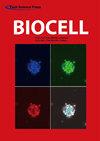设计基于自然杀伤细胞相关基因的风险预后模型,准确评估胃癌预后
IF 1
4区 生物学
Q4 BIOLOGY
引用次数: 0
摘要
背景:本研究旨在鉴定自然杀伤(NK)细胞相关基因,设计风险预后模型,准确评估胃癌(GC)预后。方法:从各数据库获取NK细胞相关基因,进行Cox回归分析和分子分型鉴定预后相关基因。利用各种免疫算法和富集分析来研究不同基因型之间的突变、免疫状态和途径变化。使用最小绝对收缩和选择算子(Lasso)回归分析和单变量Cox回归分析评估关键预后基因。然后,根据筛选出的重要预后基因构建风险评分(RS)预后模型。绘制受试者工作特征(ROC)曲线,分析模型的稳健性。随后,利用决策曲线和校准曲线对模型的可靠性和预测精度进行了评估。采用“prophytic”R软件包预测免疫治疗药物和化疗药物的半最大抑制浓度(IC50)。结果:我们筛选了21个预后基因和3个分子亚型,发现C1亚型预后最差。此外,促进肿瘤增殖的途径,如上皮-间质转化显著上调。结果还显示M2期巨噬细胞在C1亚型明显浸润,C1亚型明显过表达,并伴有严重的炎症反应。C1对5-氟尿嘧啶和紫杉醇等药物高度敏感。ROC曲线、校正曲线和决策曲线显示风险模型具有较强的稳健性和可靠性。结论:总的来说,我们提出的NK细胞相关RS模型可以作为GC患者更准确的预测指标,为个性化医疗提供有价值的贡献。本文章由计算机程序翻译,如有差异,请以英文原文为准。
Designing a risk prognosis model based on natural killer cell-linked genes to accurately evaluate the prognosis of gastric cancer
Background: This study was aimed at identifying natural killer (NK) cell-related genes to design a risk prognosis model for the accurate evaluation of gastric cancer (GC) prognosis. Methods: We obtained NK cell-related genes from various databases, followed by Cox regression analysis and molecular typing to identify prognostic genes. Various immune algorithms and enrichment analyses were used to investigate the mutations, immune status, and pathway variations among different genotypes. The key prognostic genes were assessed using the least absolute shrinkage and selection operator (Lasso) regression analysis and univariate Cox regression analysis. Thereafter, the risk score (RS) prognosis model was constructed based on the selected important prognostic genes. A Receiver Operating Characteristics (ROC) curve was plotted for analyzing the robustness of the model. Subsequently, the decision and calibration curves were used for assessing the reliability and prediction accuracy of the proposed model. The ‘pRRophetic’ R software package was utilized for predicting the half-maximal inhibitory concentration (IC50) of immunotherapy and chemotherapy drugs. Results: We screened 21 prognostic genes and three molecular subtypes and found that the C1 subtype had the worst prognosis. Further, the pathways promoting tumor proliferation, such as epithelial-mesenchymal transition were significantly up-regulated. The results also showed that the macrophages in the M2 stage were significantly infiltrated in the C1 subtype, and there was significant overexpression in the C1 subtype, accompanied by a severe inflammatory reaction. The C1 was highly sensitive to drugs like 5-fluorouracil and paclitaxel. The ROC, calibration curve, and decision curve showed that the risk model was robust and strongly reliable. Conclusion: Overall, our proposed NK cell-related RS model can be used as a more accurate prediction index for GC patients, providing a valuable contribution to personalized medicine.
求助全文
通过发布文献求助,成功后即可免费获取论文全文。
去求助
来源期刊

Biocell
生物-生物学
CiteScore
1.50
自引率
16.70%
发文量
259
审稿时长
>12 weeks
期刊介绍:
BIOCELL welcomes Research articles and Review papers on structure, function and macromolecular organization of cells and cell components, focusing on cellular dynamics, motility and differentiation, particularly if related to cellular biochemistry, molecular biology, immunology, neurobiology, and on the suborganismal and organismal aspects of Vertebrate Reproduction and Development, Invertebrate Biology and Plant Biology.
 求助内容:
求助内容: 应助结果提醒方式:
应助结果提醒方式:


